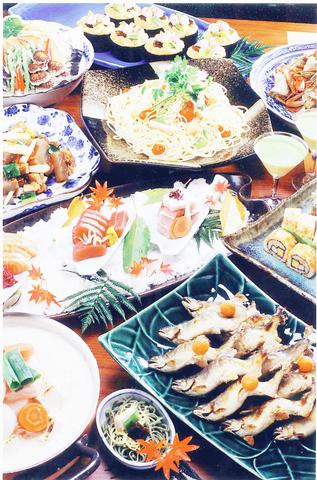Shin Yeh manager Jo Huang (
Shin Yeh has four outlets in Taipei specializing in Japanese food, with others serving Taiwanese or Mongolian roast. "The food at each outlet reflects the skills of the head chef there, and the decor and atmosphere are tailored for the specific location."
The food and beverage group has opened its newest Japanese food outlet at the new Fnac Future Center near Taipei Main Station. "We aim to provide high quality food in a buffet format," said director of operations Andy Roan (

PHOTO COURTESY OF SHIN YEH
The open plan kitchen-display tables behind which chefs in spotless whites work replenishing the food gives diners in this Shin Yeh outlet a sense of being catered to in a way that is becoming fashionable in up-market buffets. With its strong service culture, Shin Yeh has proved very successful at this.
Considerable care has been taken over presentation, and the amount of food out on the counter at any one time is kept to a minimum. This is especially effective with the sashimi, which always maintains a fresh, attractive look.
Other foods are also presented in a way that appeals to all the senses, with Japanese tidbits in elegant stoneware vessels. Some are really rather adventurous, such as yam salad or cooked black beans in sugar syrup -- both quite traditional but definitely not mainstream.
At the grill station, chefs work to turn out a steady stream of teppanyaki and the tempura is also freshly turned out, even if the batter isn't quite toothsome as that from a good a la carte establishment. But that is a minor complaint, for quality is outstanding overall, and the same spread ordered individually would cost considerably more.
The sweets have been nicely judged, with a number of Japanese twists on western deserts, now very popular, and also a number of local versions of Japanese favorites such as fruit jelly made with watermelon.
There are plenty of staff on hand to help you get the best out of your meal. If you aren't sure how best to mix the dip for the tempura, the chef behind the counter or one of the many service personnel will be there to help out.

June 23 to June 29 After capturing the walled city of Hsinchu on June 22, 1895, the Japanese hoped to quickly push south and seize control of Taiwan’s entire west coast — but their advance was stalled for more than a month. Not only did local Hakka fighters continue to cause them headaches, resistance forces even attempted to retake the city three times. “We had planned to occupy Anping (Tainan) and Takao (Kaohsiung) as soon as possible, but ever since we took Hsinchu, nearby bandits proclaiming to be ‘righteous people’ (義民) have been destroying train tracks and electrical cables, and gathering in villages

Dr. Y. Tony Yang, Associate Dean of Health Policy and Population Science at George Washington University, argued last week in a piece for the Taipei Times about former president Ma Ying-jeou (馬英九) leading a student delegation to the People’s Republic of China (PRC) that, “The real question is not whether Ma’s visit helps or hurts Taiwan — it is why Taiwan lacks a sophisticated, multi-track approach to one of the most complex geopolitical relationships in the world” (“Ma’s Visit, DPP’s Blind Spot,” June 18, page 8). Yang contends that the Democratic Progressive Party (DPP) has a blind spot: “By treating any

Swooping low over the banks of a Nile River tributary, an aid flight run by retired American military officers released a stream of food-stuffed sacks over a town emptied by fighting in South Sudan, a country wracked by conflict. Last week’s air drop was the latest in a controversial development — private contracting firms led by former US intelligence officers and military veterans delivering aid to some of the world’s deadliest conflict zones, in operations organized with governments that are combatants in the conflicts. The moves are roiling the global aid community, which warns of a more militarized, politicized and profit-seeking trend

This year will go down in the history books. Taiwan faces enormous turmoil and uncertainty in the coming months. Which political parties are in a good position to handle big changes? All of the main parties are beset with challenges. Taking stock, this column examined the Taiwan People’s Party (TPP) (“Huang Kuo-chang’s choking the life out of the TPP,” May 28, page 12), the Democratic Progressive Party (DPP) (“Challenges amid choppy waters for the DPP,” June 14, page 12) and the Chinese Nationalist Party (KMT) (“KMT struggles to seize opportunities as ‘interesting times’ loom,” June 20, page 11). Times like these can